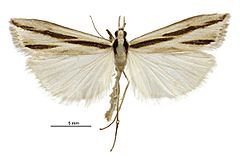Scoparia claranota facts for kids
Quick facts for kids Scoparia claranota |
|
|---|---|
 |
|
| Male | |
| Scientific classification | |
| Kingdom: | |
| Phylum: | |
| Class: | |
| Order: | |
| Family: | |
| Genus: |
Scoparia
|
| Species: |
S. claranota
|
| Binomial name | |
| Scoparia claranota Howes, 1946
|
|
Scoparia claranota is a type of moth that belongs to the Crambidae family. This moth is special because it is endemic to New Zealand. This means it is found naturally only in New Zealand and nowhere else in the world!
Contents
How Scientists Study This Moth
Scientists study and name living things using a system called taxonomy. This helps them organize all the different plants and animals on Earth.
Naming the Scoparia claranota
The Scoparia claranota moth was first described by a scientist named W. George Howes in 1946. When a scientist "describes" a species, they give it a formal name and write down all its features.
Where Does It Fit?
Even though it has a name, scientists are still learning about this moth. They are not completely sure if it fits perfectly into the Scoparia group of moths. Because of this, you might sometimes see it called Scoparia (s.l.) claranota. The "s.l." stands for "sensu lato," which is Latin for "in a broad sense." It means scientists are still figuring out its exact place in the moth family tree.
What Does This Moth Look Like?
The Scoparia claranota moth has a wingspan of about 39 millimeters (which is about 1.5 inches). This is the distance from the tip of one wing to the tip of the other when the wings are spread out.
Forewings and Hindwings
The front wings, called the forewings, are a pretty silvery-white color. They have a streak of brownish-yellow along the top edge, which is called the costa. There are also light brownish-yellow borders around the darker markings on the wings. You can see a black line that goes from the middle of the wing's base to its center. Another black line stretches from the center of the wing towards the outer edge, just above the bottom corner. The back wings, called the hindwings, are also silvery-white.
When Can You See Them?
Adult Scoparia claranota moths have been seen flying around in December.

